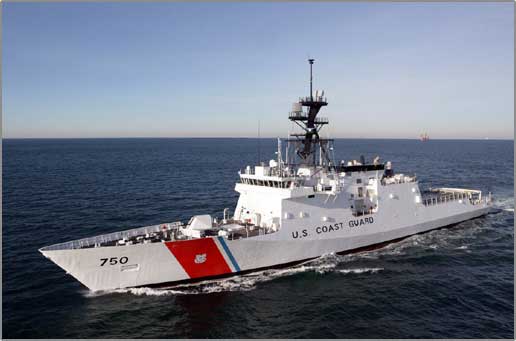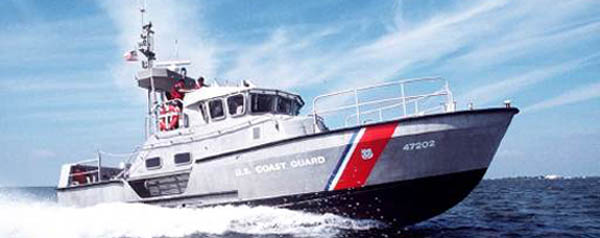The United States Coast Guard is the maritime security, search and rescue, and law enforcement service branch of the United States Armed Forces and one of the country’s eight uniformed services founded August 4, 1790. The U.S. Coast Guard uses a variety of platforms to conduct its daily business. Cutters and small boats are used on the water and fixed and rotary wing (helicopters) aircraft are used in the air.
A “Cutter” is basically any CG vessel 65 feet in length or greater, having adequate accommodations for crew to live on board. Larger cutters (over 180 feet in length) are under control of Area Commands (Atlantic Area or Pacific Area). Cutters at or under 180 feet in length come under control of District Commands. Cutters, usually have a motor surf boat and/or a rigid hull inflatable boat on board. Polar Class icebreakers also carry an Arctic Survey Boat (ASB) and Landing Craft.
(Approximately 1400 – number fluctuates). All vessels under 65 feet in length are classified as boats and usually operate near shore and on inland waterways. Craft include: Motor Lifeboats; Motor Surf Boats; Large Utility Boats; Surf Rescue Boats; Port Security Boats; Aids to Navigation Boats; and a variety of smaller, non-standard boats including Rigid Inflatable Boats. Sizes range from 64 feet in length down to 12 feet.
There are a total of 211 aircraft in CG inventory. This figure fluctuates operationally due to maintenance schedules. Major Missions: Search/Rescue, Law Enforcement, Environmental Response, Ice Operations, and Air Interdiction. Fixed-wing aircraft (C-130 Hercules turboprops and HU-25 Falcon jets) operate from large and small Air Stations. Rotary wing aircraft (HH-65 Dolphin and HH-60 Jayhawk helicopters) operate from flight-deck equipped Cutters, Air Stations and Air Facilities.

Cutter, Boat, and Aircraft
Cutters
420′ Icebreaker (WAGB)
418′ USCG Bertholf (WMSL 750) Legend class National Security Cutter fleet
399′ Polar Class Icebreaker (WAGB)
378′ High Endurance Cutter (WHEC)
290′ Inland Icebreaker (WAGB)
295′ Training Barque Eagle (WIX)
282′ Medium Endurance Cutter (WMEC)
270′ Medium Endurance Cutter (WMEC)
230′ Medium Endurance Cutter (WMEC)
225′ Seagoing Buoy Tender (WLB)
213′ Medium Endurance Cutter(WMEC)
210′ Medium Endurance Cutter (WMEC)
180′ Seagoing Buoy Tender (WLB)
175′ Coastal Buoy Tender (WLM)
179′ Patrol Coastal (WPC)
160′ Inland Construction Tender (WLIC)
140′ Icebreaking Tug (WTGB)
123′ Patrol Boat (WPB)
110′ Patrol Boat (WPB)
100′ Inland Buoy Tender (WLI)
100′ Inland Construction Tender (WLIC)
87′ Coastal Patrol Boat (WPB)
75′ River Buoy Tender (WLR)
75′ Inland Construction Tender (WLIC)
65′ River Buoy Tender (WLR)
65′ Inland Buoy Tender (WLI)
65′ Small Harbor Tug (WYTL)

U.S. Coast Guard Coastal Patrol Boat
Length: 87 feet
Beam: 19 feet 5 inches
Power plant: 2 Diesel engines
Commissioned: 1998-Present
The newly designed 87′ Coastal Patrol Boat has several enhancements over the aging 82s, including improved mission sea keeping abilities (up to sea state 5), significantly upgraded habitability, and compliance with all current and projected environmental protection laws. It also employs an innovative stern launch and recovery system using an Aluminum hulled inboard diesel powered waterjet small boat. The vastly larger pilot house is equipped with an integrated bridge system including an electronic chart display system (ECDIS) which interfaces with the CG’s new surface search radar. SWIII computers along with a fiber optic network will also be installed, allowing the crew to access the vessel’s CD-ROM tech pubs and drawings.
Boats
47′ Motor Life Boat (MLB)
44′ Motor Life Boat (MLB)
41′ Utility Boat (UTB)
38′ Deployable Pursuit Boat (DPB)
21′-64′ Aids to Navigation Boats
25′ Transportable Port Security Boat (TPSB)
Rigid Hull Inflatable Boat (RHI)

47′ Motor Life Boat (MLB)
Length: 47 feet
Special Characteristics: Self-righting (if overturned, the vessel
will return to an upright position in 8 seconds or less).
The 47′ motor lifeboat is designed as a first response rescue resource in high seas, surf & heavy weather environments. They are built to withstand the most severe conditions at sea and are capable of effecting a rescue at sea even under the most difficult circumstances. They are self-bailing, self-righting, almost unsinkable, and have a long cruising radius for their size. It is the replacement for the aging 44′ MLB fleet. There are (presently) 81 operational, being added to monthly. The total (to be delivered over 5 years) will be about 200.
Aircraft
HC-130 Hercules
HU-25 Guardian
HH-60 Jayhawk
HH-65 Dolphin
MH-68A Stingray
Average Day with The U.S. Coast Guard
Each day, the men and women of the 35,000 plus active duty Coast Guard, 8,000 Reservists and 32,000 Auxiliarists provide services over 3.4 million square miles of Exclusive Economic Zones..
- Conduct 109 Search and Rescue Cases.
- Save 10 lives.
- Assist 192 people in distress.
- Protect $2,791,841 in property.
- Small boats are underway for 396 sorties/missions.
- Aircraft fly 164 missions, logging 324 hours, of which 19 hrs are flown off patrolling cutters.
- Law enforcement teams board 144 vessels.
- Seize 169 pounds of marijuana and 306 pounds of cocaine worth $9,589,000.00.
- Seize 1 drug smuggling vessel every five days
- Cutter and small boat crews interdict and rescue 14 illegal migrants.
- Marine Safety personnel open 8 new cases for marine violation of federal statutes
- Process 238 Seaman licenses and documents.
- Marine Inspectors board 100 large vessels for port safety checks.
- Vessel examiners conduct 20 commercial fishing vessel safety exams and issue 11 fishing vessel compliance decals.
- Pollution investigators respond to 20 oil or hazardous chemical spills totaling 2,800 gallons.
- Investigate 6 vessel casualties involving collisions, allisions or groundings.
- Buoy tenders and Aids to Navigational Teams service 135 aids to navigation.
- Vessel Traffic Service controllers assist 2,509 commercial ships entering & leaving U.S. ports.
- Icebreakers and buoy tenders assist 196,938 tons of shipping daily during the Great Lakes ice season.
- International Ice Patrol sorties provide ice safety information to facilitate the 163,238 tons of shipping during the North Atlantic ice season.
- Auxiliarists conduct 377 vessel safety checks and teach boating safety courses to 550 boaters.
WARNING! Do not approach within 100 yards of any U.S. naval vessel. If you need to pass within 100 yards of a U.S. naval vessel in order to ensure a safe passage in accordance with the Navigation Rules, you must contact the U.S. naval vessel or the Coast Guard escort vessel on VHF-FM channel 16.100. You must operate at minimum speed within 500 yards of any U.S. naval vesseland proceed as directed by the Commanding Officer or the official patrol. Violations of the Naval Vessel Protection Zone are a felony offense, punishable by up to 6 years in prisonand/or up to $250,000 in fines
